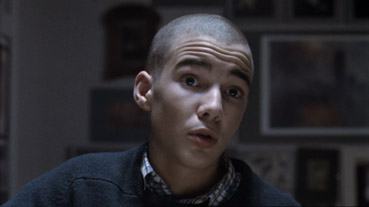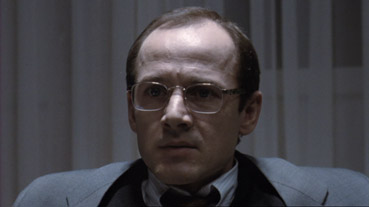|
The
pre-credits sequence of the second installment of Michael
Haneke's so-called 'Glacial trilogy' (a term the director
now laughs at having coined), Benny's Video
(1992), will quickly deter a good many of those who
might have problems with the film that follows. Shot on
grainy 8mm video, it shows a pig being led out of a barn
and then killed with a captive bolt pistol.
We then watch as the tape is rewound and the killing is
repeated in slow motion. Although this is a common (and,
it is considered, 'humane') method employed for farmyard animal
slaughter, it's one of those things that few of us actually want
to see even as we tuck into our bacon sandwiches
and pork chops. What may initially seem like a cheap shock
tactic has very specific bearing on the story that follows.
If
you have never seen Benny's Video and know
little about it, then I'd seriously consider bypassing the
rest of this review and watching the film cold, as I did
when I first saw it. It's impact is undoubtedly heightened
by an innocence of what is about to hit you and to discuss
the film in any detail requires revealing some of the plot
points that it is worth being surprised or shocked by. If you've seen
the film or already know how the narrative bends, then by
all means proceed.

Once
the credits are out of the way, Benny's Video
proceeds in deceptively hum-drum fashion, as the video-obsessed
young Benny of the title shoots footage of his sister's
impromptu party, borrows money-making schemes from her to
turn a buck at school, and rents trashy movies from the
local store to watch in bed at night. His mother and father
are straight-laced professionals and are happy to leave
him in charge of their flat while they are away for the
weekend. And that's when everything changes. Benny meets
a young girl outside of the video store he frequents and
invites her back to the flat. The two eat, watch some video
(including the pig killing, which the girl does not shy
away from), and then Benny shows her the captive bolt pistol
he stole from the farm at which he shot the footage. He
loads the weapon and the two dare each other to pull the
trigger, the badge of coward used as a taunt for the hesitant,
with the inevitable and terrible result.
The
girl's death, a violent narrative disruption of the sort
Haneke would use again in later films (see Hidden
to experience this at its most shocking and unexpected),
is made all the more disturbing by its protracted nature.
Unlike the opening pig slaughter, it takes three clumsily
executed shots for her to die, an action caught only in
part by Benny's video camera, her suffering communicated
to the audience almost solely through her screams.
If
the killing itself is shocking, then Benny's casual indifference
to his actions (he interrupts the task of hiding the body
and cleaning up the blood in order to eat, write and arrange a night
out with a friend) and the reaction of his parents on discovering
the crime is all the more so. Here Haneke highlights what
he sees at the Austrian trait of brushing things under the
carpet, but in the process delivers a particularly scathing
condemnation of bourgeois self-centredness. Benny's mother
and father think not of the murdered girl or her family
but how the crime would reflect on them as parents and affect
their son's future prospects, and their decision to cover
it up and dispose of the body is reached with troubling
ease.
The
subsequent journey to the jarring final twist is a continuously
uncomfortable one, as we are physically and morally removed
from the crime scene but remain connected to its consequences
by the niggling reminders of the terrible task being undertaken
back home by Benny's father. By offering no concrete reasons
for Benny's actions or subsequent behaviour, Haneke also
provides no way for the viewer to easily explain them away.
This is probably just as well, as the small hints that are present – Benny
watches trashy horror movies, listens to heavy metal music,
eats fast food, reads comic books – are the same old scapegoat
triggers you'll find in a thousand tabloid news stories,
and ones that sit uneasily in a drama as intelligent and
boldly handled as this.

Inevitably,
Benny's Video anticipates Haneke's notorious
1997 Funny Games, a film that takes some
of the themes explored here to an altogether more challenging
level. The association is heightened by the recasting in the later film of
young Arno Frisch as the boy Benny might just grow to become
(prefigured here by the post-killing crew-cut that visually
transforms him into the psychotic Paul of the later film)
and Ulrich Mühe as the father he arrives to torment. Although
never quite as harrowing as Funny Games (but then, what is?), Benny's Video is nonetheless uncomfortable
and sometimes disturbing, a film that in typical Haneke
fashion can frustrate even as it impresses.
When asked by
his father why he killed the girl, Benny responds, "to
see what it felt like." For Haneke this appears to
be the essence of the story (this real-life response to that
very question, given by a young killer, was what first triggered
the project). If an individual, and by implication the society
in which that individual comfortably exists, experiences
reality largely as a media-filtered and delivered experience,
what happens to their ability to make moral judgements and
connect with the consequences of their actions? Whether
you agree with Haneke's conclusions or not – and there are
plenty of convincing arguments for either viewpoint – it
remains troubling and provocative viewing.
The
anamorphically enhanced 1.78:1 transfer is similar to those
on the other two films in this set, with contrast, colour
and detail generally good, but a slight softness to the
picture and a drop-off in quality in dimly lit scenes. This
is especially evident in shots of Benny sleeping or attempting
to sleep, where grain and compression artefacts are very
visible.
Once
again the Dolby 2.0 mono serves its purpose well enough,
and never feels in need of any sort of remix. Clarity is
fine and there are no distortion issues.
Only
one here, and that's the Michael Haneke Interview (20:45), which is once again informative and enjoyable,
although I feel the need to take issue with the director
over his bemusement at the idea of taking photos or video
while on holiday and his suggestion that it is because people
are only so detached from reality that they can only experience
life through some sort of media. Obviously this is nonsense
– people take holiday pictures as a memory aid, to prolong
an enjoyable experience by providing a thousand words' worth
of links to past experiences and to preserve detail that
would otherwise inevitably fade. I have no doubt that Haneke
knows this to be true and is playing the provocateur here,
in part because the argument sits so well with the film's
themes.
A
morally challenging work, but if you've made your way through
a couple of other Haneke films then you'd expect nothing
less, although if you're looking at it metaphorically, some
will find the underlying assumptions about society a little
simplistic. For those who have discovered the director via
his later work, it should be considered essential viewing.
Animal lovers might want to give this one a miss.
|